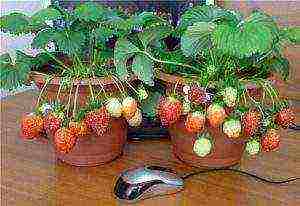Content
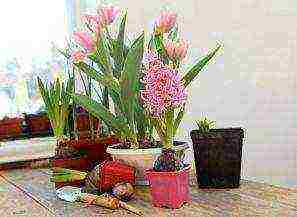
Spring flower bed in the house with your own hands
Spring bulbs can be admired not only in the spring in the garden, but even in winter - at home on the windowsill.
Not every tulip, daffodil or hyacinth bulb is suitable for forcing. You need to choose the largest, heaviest, densest, healthiest. You should not expect full flowering from a large, but loose bulb. There are not enough nutrients in the scales of the plant, and this will affect the quality of the flowers.
It is better for novice flower growers to purchase bulbs specially prepared in flower farms. If you decide to use bulbs from your garden, they will need to be specially prepared for forcing. Choose plants with the sturdiest stems. After the bud is colored and you are sure that the flower is not sick with the variegated petrolatum virus, break it off. A bulb that will not expend energy on flowering will form a large replacement, which you will then use for forcing.
By the timing of flowering, early (from mid-December to mid-January) and late (from mid-January and inclusive to April) forcing are distinguished. This must be taken into account when choosing bulbous varieties, which are also subdivided by flowering time into early, mid-flowering and late.
All bulbs must go through several preparatory steps before forcing. Each bulbous plant has its own.
Tulips. Growing at home
The bulbs after digging (or from the moment of purchase unprepared) are kept at a temperature of + 20-23 ° C. A month before planting, they are kept for 2 weeks at a temperature of + 17 ° С and for the remaining 2 weeks before planting (especially if it is an early distillation by the New Year), the bulbs are heated, that is, they are kept at a temperature of + 30-34 ° С.
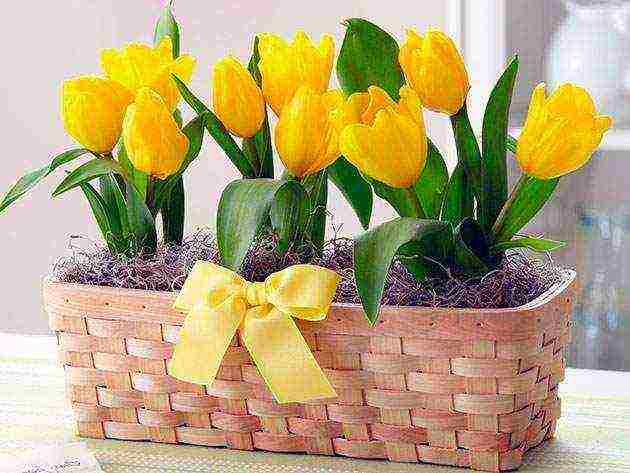
Daffodils. Growing at home
For forcing daffodils for the New Year holidays, you need to choose early flowering varieties. Purchased or dug out bulbs until the end of October should be stored in a dry, dark place at a temperature of + 4-6 ° C. For example, in the basement or between window frames (then it is imperative to protect the bulbs from sunlight by wrapping them in black paper).
If you want to please yourself with a bouquet of daffodils by March 8, then you need to store the bulbs like this throughout January and plant them in pots with soil at the beginning of February.
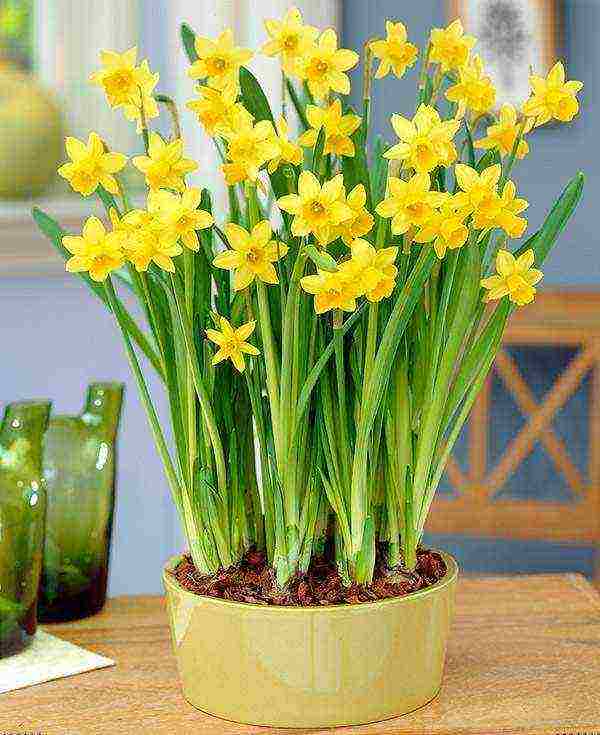
Hyacinths. Growing at home
From digging (from the moment of purchase) to planting, the bulbs lie at a temperature of + 25 ° C. A month before planting, they are kept for 2 weeks at room temperature (+ 18-20 ° С) and the remaining 2 weeks before planting (especially if it is an early distillation by the New Year) - in a warm place at a temperature of + 30 ° С.
The planting container should be low (but not lower than two bulb heights) and wide. A drainage layer is poured at the bottom. All bulbs are planted so that 1/3 is above the ground. They plant them close to each other, but do not allow contact. The primer should be lightweight, breathable. A versatile flower primer with 2: 1 sand is suitable. If there is no sand, it can be replaced with vermiculite or perlite. When planting, you do not need to press the bulbs hard or screw in, the bottom should not be damaged. You just need to carefully set the bulbs and cover them with soil from the sides. Now they should be in the dark and at a low positive temperature.
The soil is moistened, but not much, only so that the moisture reaches the bottom of the bulb.Then the pots are placed on the lower shelf of the refrigerator or lowered into the cellar, where the temperature is kept no higher than + 7-9 ° C. Never cover the pots or put them in plastic bags. Polyethylene will not allow air to pass through, which will cause the earth to become moldy, and, of course, the bulbs will suffer. If, nevertheless, this happens, then the topsoil is changed to a fresh one.
To prevent light from falling on the bulbs, it is better to cover them, but loosely, with a black cloth or paper.
On the bottom shelf of the refrigerator, we artificially create early spring conditions. Tulip bulbs take 3 months to fully root, and later varieties take 4 months; daffodils - within 2.5-3 months; hyacinths take root for 2-3 months. At this time, you need to carefully monitor the moisture content of the soil: it should not completely dry out, but it is categorically impossible to fill it "for future use". As soon as green shoots 2-2.5 cm long appear, the pots are moved to a brighter place, but again not sunny and not too hot for 4-6 weeks. The temperature should be kept within + 10-15 ° С. This happens in an unheated room or on a loggia. The pots can be placed on the floor, because if there is too much light, the leaves will begin to reach for it and take all the strength from the bulb to grow. Then flowering may not come at all.
When the leaves noticeably grow on the bulbs and a small but strong bud still appears between them, the plants begin to water more abundantly, gradually accustom them to room temperature and bring them out into the light. When the temperature rises sharply, flowering will be very short. If the buds are already colored, and the peduncle is still too short, then the pots are placed in a cool and dark place for several days.
We recommend watching:
How to grow drip beloperone at home
Unpretentious indoor plants photo and name
How to grow hibiscus at home
How to grow a gardenia at home
No comments yet. Yours will be the first!
Usually spring bulbs are planted near the house in flower beds, in flower beds or mixborders. This method is good for everyone, except for one thing - all this variety of crocuses, tulips and daffodils does not bloom for long, leaving ugly withered leaves on the surface of the earth. We have to dig up the bulbs and transfer them to the inconspicuous backyards of the site in order to plant summer flowers in the vacant place. Inconvenient. In Europe, a different method of growing bulbs has long been used - in containers or pots. In yards, where the entire surface of the earth is occupied by a lawn, this method will come in handy. It is also a great opportunity to landscap a terrace, veranda, paved patio or concrete path borders.
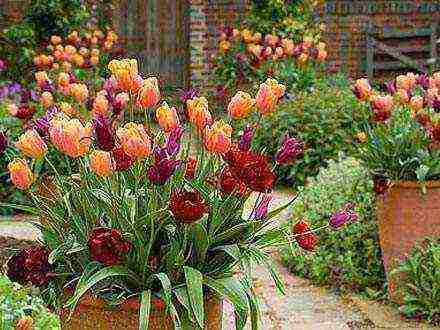
Armfuls of spring tulips bring color to the monochrome paved courtyard style
Despite the fact that we will admire the beauty of the flowering of bulbs in pots only in the spring, planting should be carried out in the fall - in October or November.
How to plant: together or separately?
Before we get into planting, let's define some compositional issues. The easiest way is to plant several types of bulbous plants in separate small pots. By changing their position relative to each other, you can create new flower arrangements every time. Also, this method will be convenient for masking bald spots in flower beds, where the flyers have not yet managed to climb.
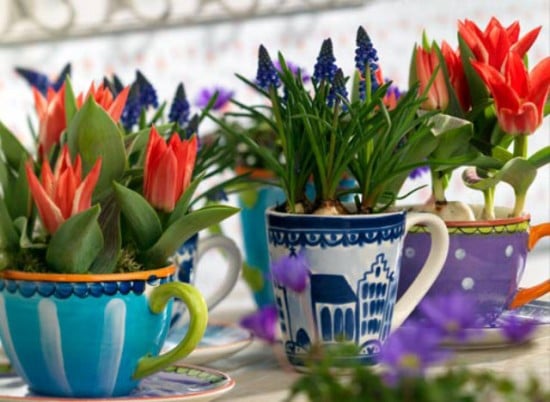
Separate planting will prevent the spread of a fungal disease of one type of bulb in the entire collection
If desired and in the presence of a large pot (flowerpot, container), you can arrange mixed plantings. To do this, in one container, several sequentially flowering bulbous are planted in layers, the decorativeness of which will alternate throughout the spring. Often daffodils, tulips and crocuses are selected for such blooming "pies".Firstly, all these plants are very beautiful and finding their bulbs in any flower shop is not a problem. Secondly, such a "composition" guarantees decorative plantings for a rather long time.

Bouquet of tulips, hyacinths and muscari in one pot
Preparatory work with "etching"
After purchasing the bulbs and pots (or one large container), it's time to plant. You should know that it is impossible to plant the bulbs without preliminary treatment - it is highly likely that they are infected with fungi. Therefore, the planting material should be "etched" - hold for 30 minutes in a solution of potassium permanganate or any fungicide (Maxim, Fundazol, karbofos, etc.).
Planting bulbs in pots
Prepared bulbs are planted in pots at a distance of 2-3 cm from each other (horizontally). From above they are sprinkled with a layer of soil, the thickness of which is:
- 12-15 cm - for daffodils
- 7-10 cm - for tulips
- 3-5 cm - for crocuses and hyacinths

Planting scheme for several types of bulbous in one pot
The plantings are generously spilled with water so that the water drains from the drainage holes. It is advisable to sprinkle the surface of the soil with sand or, if small frosts are expected in the place of future storage, mulch with sawdust. To prevent out-of-class germination of plants, the pots are covered with an opaque material and taken to the storage area.
Stratification - cold storage
For bulbous plants, the period of stratification is important - cold tests. In other words, in order for the bulbs to sprout, they should be placed in a cool place for a while. Therefore, pots with plantings are stored on a glazed veranda, terrace or any outbuilding where the air temperature in winter will be kept in the region of 3-8 ° C. In principle, short-term temperature drops below zero are allowed, but this should be the exception rather than the rule.
You should know that the temperature for rooting of most bulbous plants is 5-10 ° C. Therefore, if during planting it turns out that the temperature in the place of their future content has dropped below the permissible limit, stratification should be postponed for several days (up to a week). Leave the pots in a warm room where the bulbs will take root safely. Then you can send the pots to cool storage.
The period of stratification (storage) is usually 2-3 months. After that, you can bring the planting into a warm room. Usually, by this time, sprouts are already visible on the surface of the soil in pots. Flowering after an increase in temperature occurs in 2-4 weeks (depending on the type of planted bulbs).
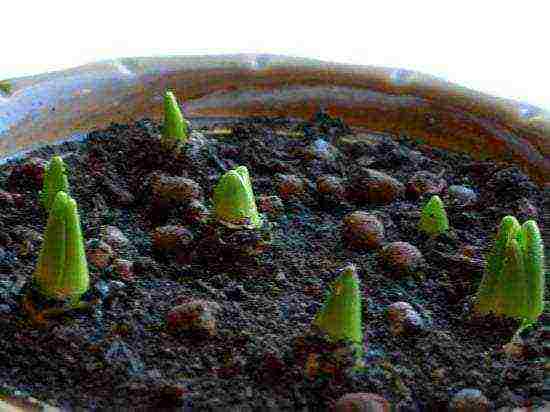
The "noses" of tulips have hatched, which means that soon we should expect flowering
If you plan to decorate an outdoor area with flowering bulbs (a terrace, paths, etc.), then wait for the natural temperature rise outside. Then the potted bulbous plants will bloom at the same time as the soil ones.
Secrets of caring for bulbs in pots
There are no particular difficulties in caring for potted bulbs. The main thing is to water and fertilize them in time. It is very important to provide plants with good lighting, otherwise they will stretch and lose their "marketable" appearance.
Coolness is another important component of proper care. In a hot room, the flowering of bulbous will be reduced to a minimum, therefore the most optimal temperatures for the content are 10-19 degrees. This is the temperature of flowering bulbs in their natural environment, that is, in the open field.

Bulbs in pots will bloom for the longest time outdoors, and not at home or on a glazed veranda.
Thus, if you manage to reproduce the natural growing conditions in a cramped pot, then already at the beginning of March you can decorate your site with armfuls of bright flowers and bring the feeling of spring closer.
A large number of species of bulbous plants are known, so compositions with their participation can be created for any time of the year.
Tulips, Jonquilia daffodils and hyacinths are the most popular spring flowers. Lilies delight us in summer, and cyclamens and autumn crocuses in autumn. In winter, our gray days will be brightened up by snowdrops and dwarf irises.
A good start
The bulb is a miniature plant, it consists of fleshy scales, and the tuber is a modified shoot with a thickened stem. Bulbous and tuberous plants can be grown not only outdoors, but also indoors. Many bulbous and tuberous plants are known.
Planting bulbs
Choose only healthy, fleshy bulbs with no signs of damage or rot on the scales. Their size depends on the type of a particular plant. It is best to buy the bulbs before planting. Try to plant them immediately after purchasing. On the packages with bulbs, the time is indicated when you need to plant them in the ground. However, you should just remember that bulbous plants blooming in late winter and spring are planted in September or October, tulips can be planted even in November.
If you want spring-flowering plants to bloom in the house ahead of time, then try to get the bulbs already prepared for forcing. Also, remember that hyacinths from bulbs that are not ready for forcing will bloom earlier if brought home early in the growing season.
Care
The bulb should be watered very sparingly until visible signs of growth appear. Water the plants abundantly during the growing season. Before planting in late autumn, you need to add a small amount of bone meal to the ground; during the growing season, bulbous plants are fed every 14 days with liquid complex fertilizers. If the bulbs in pots and tubs will winter outside, then take care of insulating the containers, sprinkle the ground with peat on top to protect the plants from severe frosts.
Lightning effect
Colchicum blooms without problems in the fall in the house. Make sure the flower buds have already been released on the tubers. All you have to do is place them, for example, in a bowl of sand or pebbles. Their pink or white flowers will have an unforgettable effect.
Planting tubers
1. Do not forget to put a thick layer of drainage, for example, from clay shards, on the bottom of the pot, only then pour compost soil into the container.
2. Arrange the bulbs with the pointed end up. Plant them closely, but not touching each other or the sides of the flowerpot. In no case should they be screwed into the substrate.
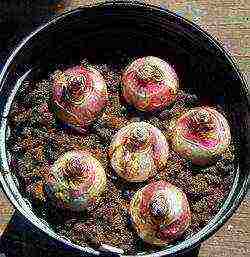
3. Sprinkle soil on the planted bulbs, lightly flatten the surface of the ground, and then water so that the soil is slightly damp.
Forcing bulbs
Preparing the bulbs
Forcing is the germination of the bulbs so that they bloom faster. Bulbs of tulips, daffodils, crocuses and hyacinths are used for forcing. Forcing plants bloom in the house in winter or early spring. To prepare the bulbs, you need to alternately keep them first at a low and then at a higher temperature. The bulbs are kept in the dark and cool for 8 to 14 weeks.
In the fall, plant the bulbs in pots filled with bulb soil. Place a drainage layer on the bottom of the pot. The tops of the bulbs should be on the soil surface. Water the bulbs and place the pot in a dark and cool place. If the air temperature is too high, the bulbs will take root and grow. Maintain constant soil moisture. When the shoots have reached a height of 3 cm, move the flower pots with the plants to a warm room.
Unprepared onions
Bulbous plants from unprepared bulbs can be grown independently. To do this, you can use the bulbs of crocuses, snowdrops, jonquil daffodils and miniature tulips.
At the end of flowering
Forcing plants do not bloom a second time.At the end of the flowering of the bulbous plants, the bulbs are transferred to the garden and planted in open ground. After a few years, their bulbs can be used again for forcing.
Compositions
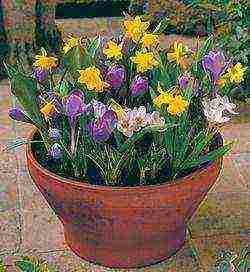 Try combining bulbous plants with undersized or creeping (ground cover) species. Tulips, jonquil daffodils and hyacinths can be combined with daisies, Vittroca violets or dwarf ornamental onions. Dwarf species and varieties look very good in stone troughs in the company of small alpine plants such as shaved and sedum. Bulbous plants also look beautiful at the foot of low bushes planted in large flower pots or tubs, for example, near miniature conifers.
Try combining bulbous plants with undersized or creeping (ground cover) species. Tulips, jonquil daffodils and hyacinths can be combined with daisies, Vittroca violets or dwarf ornamental onions. Dwarf species and varieties look very good in stone troughs in the company of small alpine plants such as shaved and sedum. Bulbous plants also look beautiful at the foot of low bushes planted in large flower pots or tubs, for example, near miniature conifers.
Spring bulbs can be admired not only in the spring in the garden, but even in winter - at home on the windowsill.
Not every tulip, daffodil or hyacinth bulb is suitable for forcing. You need to choose the largest, heaviest, densest, healthiest. You should not expect full flowering from a large, but loose bulb. There are not enough nutrients in the scales of the plant, and this will affect the quality of the flowers.
It is better for novice flower growers to purchase bulbs specially prepared in flower farms. If you decide to use bulbs from your garden, they will need to be specially prepared for forcing. Choose plants with the sturdiest stems. After the bud is colored and you are sure that the flower is not sick with the variegated petrolatum virus, break it off. A bulb that will not expend energy on flowering will form a large replacement, which you will then use for forcing.
By the timing of flowering, early (from mid-December to mid-January) and late (from mid-January and inclusive to April) forcing are distinguished. This must be taken into account when choosing bulbous varieties, which are also subdivided by flowering time into early, mid-flowering and late.
All bulbs must go through several preparatory steps before forcing. Each bulbous plant has its own.
Tulips. Growing at home
After digging (or from the moment of purchase, unprepared bulbs) are kept at a temperature of + 20-23 ° C. A month before planting, they are kept for 2 weeks at a temperature of + 17 ° С and for the remaining 2 weeks before planting (especially if it is an early distillation by the New Year), the bulbs are heated, that is, they are kept at a temperature of + 30-34 ° С.
Daffodils. Growing at home
For forcing daffodils for the New Year holidays, you need to choose early flowering varieties. Purchased or dug out bulbs until the end of October should be stored in a dry, dark place at a temperature of + 4-6 ° C. For example, in the basement or between window frames (then it is imperative to protect the bulbs from sunlight by wrapping them in black paper).
If you want to please yourself with a bouquet of daffodils by March 8, then you need to store the bulbs like this throughout January and plant them in pots with soil at the beginning of February.
Hyacinths. Growing at home
From digging (from the moment of purchase) to planting, the bulbs lie at a temperature of + 25 ° C. A month before planting, they are kept for 2 weeks at room temperature (+ 18-20 ° С) and the remaining 2 weeks before planting (especially if it is an early distillation for the New Year) - in a warm place at a temperature of + 30 ° С.
The planting container should be low (but not lower than two bulb heights) and wide. A drainage layer is poured at the bottom. All bulbs are planted so that 1/3 is above the ground. They plant them close to each other, but do not allow contact. The primer should be lightweight, breathable. A universal flower primer with the addition of sand in a 2: 1 ratio is suitable. If there is no sand, it can be replaced with vermiculite or perlite. When planting, you do not need to press the bulbs hard or screw in, the bottom should not be damaged.You just need to carefully set the bulbs and cover them with soil from the sides. Now they should be in the dark and at a low positive temperature.
The soil is moistened, but not much, only so that the moisture reaches the bottom of the bulb. Then the pots are placed on the lower shelf of the refrigerator or lowered into the cellar, where the temperature is kept no higher than + 7-9 ° C. Never cover the pots or put them in plastic bags. Polyethylene will not allow air to pass through, which will cause the earth to become moldy, and, of course, the bulbs will suffer. If, nevertheless, this happens, then the topsoil is changed to a fresh one.
To prevent light from falling on the bulbs, it is better to cover them, but loosely, with a black cloth or paper.
On the bottom shelf of the refrigerator, we artificially create early spring conditions. Tulip bulbs take 3 months to fully root, and later varieties take 4 months; daffodils - within 2.5-3 months; hyacinths take root for 2-3 months. At this time, you need to carefully monitor the moisture content of the soil: it should not completely dry out, but it is categorically impossible to fill it "for future use".
As soon as green shoots 2-2.5 cm long appear, the pots are moved to a brighter place, but again not sunny and not too hot for 4-6 weeks. The temperature should be kept within + 10-15 ° С. This happens in an unheated room or on a loggia. The pots can be placed on the floor, because if there is too much light, the leaves will begin to reach for it and take all the strength from the bulb to grow. Then flowering may not come at all.
When the leaves noticeably grow on the bulbs and a small but strong bud still appears between them, the plants begin to water more abundantly, gradually accustom them to room temperature and bring them out into the light. When the temperature rises sharply, flowering will be very short. If the buds are already colored, and the peduncle is still too short, then the pots are placed in a cool and dark place for several days.

